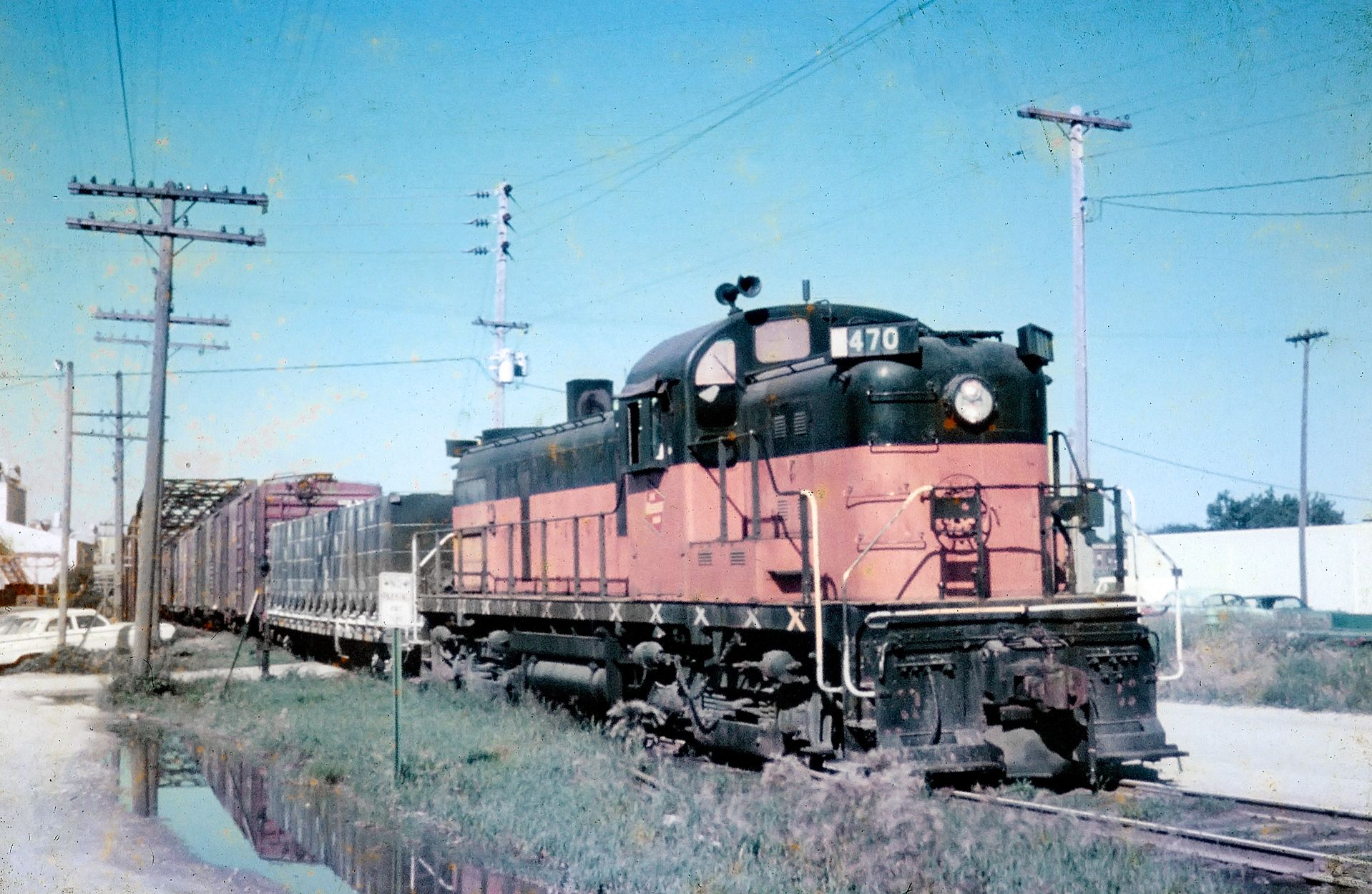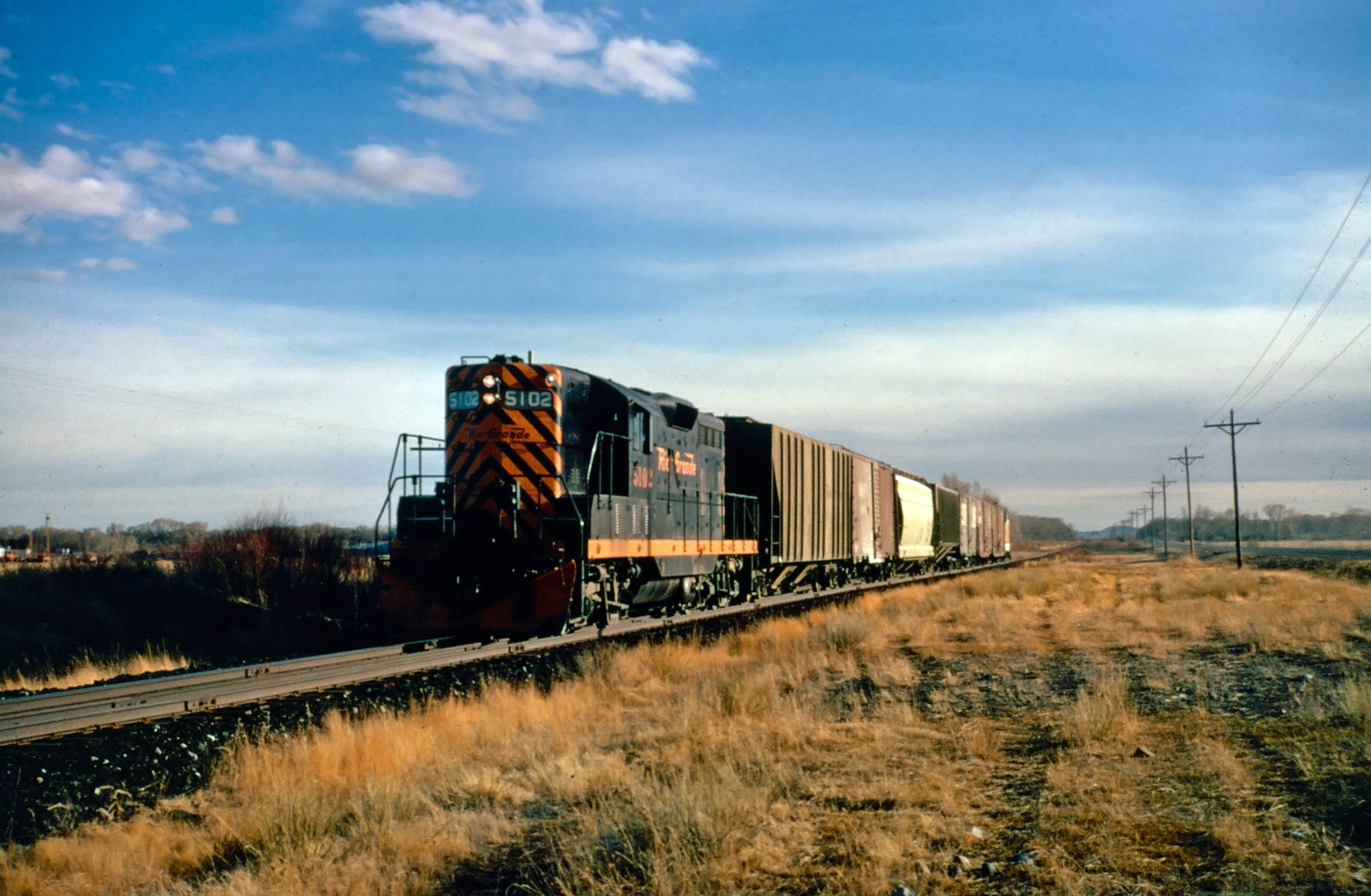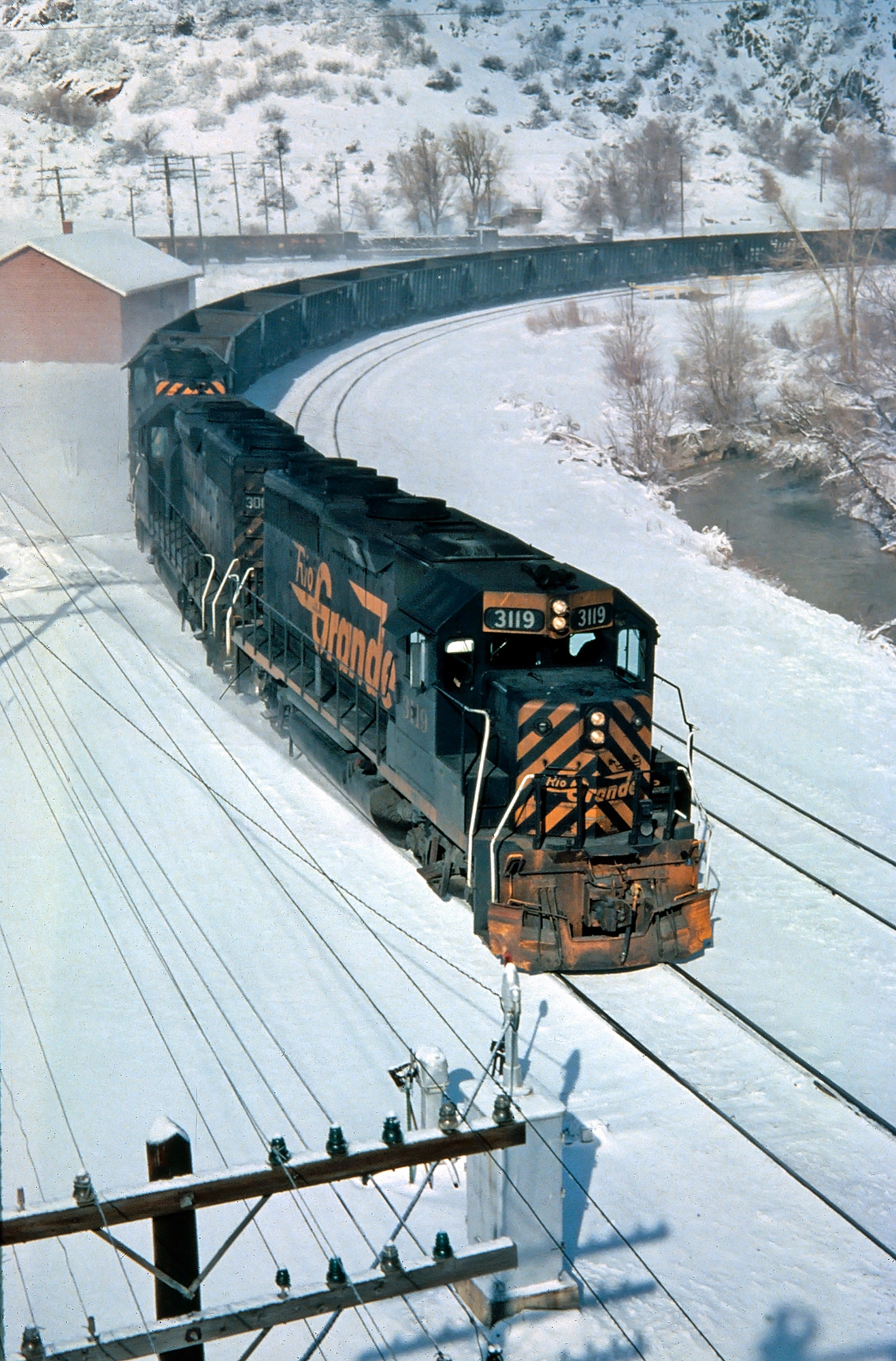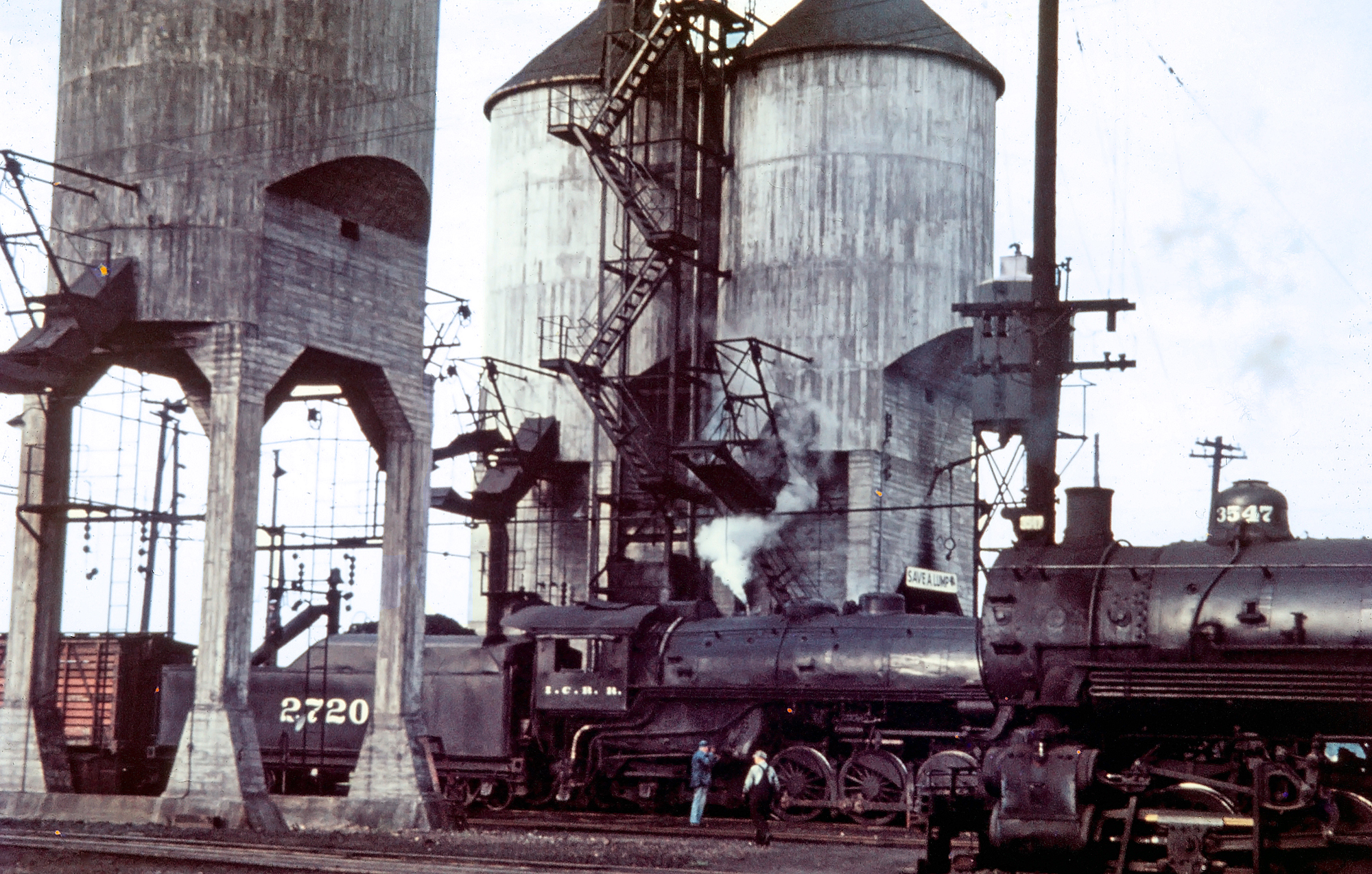Motive Power: Keeping Trains Moving
Last revised: November 2, 2024
By: Adam Burns
Below are many motive power and equipment terms that cover
everything from various diesel locomotive designations to what the term
"piggyback" means in railroad jargon.
Also, if you have any questions about the meanings of any of these definitions or simply have more to add that are not covered here please do not hesitate to get in touch with me.
Lastly, I do hope that the below terms and meanings are of help and beneficial use to you, as that is the main reason for providing the information presented here!
It should be noted that the definitions listed here are organized in alphabetical order to better and more easily allow you to find exactly what you are looking for.
 Milwaukee Road RS3 #470 works freight service over the Cedar River at Cedar Rapids, Iowa in June, 1969. Fred Byerly photo. American-Rails.com collection.
Milwaukee Road RS3 #470 works freight service over the Cedar River at Cedar Rapids, Iowa in June, 1969. Fred Byerly photo. American-Rails.com collection.Motive Power and Equipment Terms
A1A-A1A: Diesel or electric locomotive wheel arrangement of two 3-axle trucks whereby the two outer axles are powered but the center axle is unpowered.
Auxiliary power-cab unit (APCU): This type of unit is used in "Push-Pull" operations for passenger service and includes an engineer's cab at the other end of the train from the locomotive whereby controls are available to operate the train.
Air test: Checking a train's air brakes to make sure that they are functioning correctly before beginning a journey.
All black: An "all clear" signal that means the train has no defects which would be noticeable against the black running gear.
Alco 251: The 251 engine replaced Alco's trouble-prone 244 model and was built between 1953 and 1969 (at which point locomotives were fairly reliable from then on), and today Montreal Locomotive Works and Bombardier continue to produce the engine.
Interestingly, there is a distinct meaning behind the engine's 251 designation: the "2" describes the 9-inch cylinder diameter and 10-inch stroke while the "51" refers to the year the engine was first tested.
APU: Stands for auxiliary power unit.
Angle cock: The valve found at the ends of locomotives and freight/passenger cars. These valves are almost always found in the open position on cars found within a train to allow the air to flow properly but closed at the end to keep proper air pressure maintained.
Anti-climber: This feature on a locomotive prevents obstructions that might be on the right-of-way in front of the locomotive from climbing up to the cab and possibly injuring the crew. They are found on either end of the locomotive.
ATC: Standing for Automatic Train Control, a feature in new locomotives which among other features, regulates the train's speed (for instance if the train exceeds a signal's speed limit the brakes are automatically applied).
ATS: Standing for Automatic Train Stop this technology (found either equipped to the locomotive or along the right-of-way) is required with speeds of 79 mph and above, it will automatically apply the brakes if the engineer does not recognize a restrictive signal within 20 seconds of passing it.
B-B: Diesel locomotives with four axles, each driven by a traction motor.
 Rio Grande GP7 #5102 leads a short freight northbound along the dual-gauge Antonito Branch between Antonito and Alamosa, Colorado along U.S. 285, circa 1967. American-Rails.com collection.
Rio Grande GP7 #5102 leads a short freight northbound along the dual-gauge Antonito Branch between Antonito and Alamosa, Colorado along U.S. 285, circa 1967. American-Rails.com collection."Bipolar": Built by General Electric in 1918 for the Milwaukee Road it was officially known as the Bipolar Gearless Type.
It gained its name because each traction motor had only two poles mounted directly on the locomotive chassis beside each axle, employing low-speed motors with the motor armatures mounted directly on the axle.
Because there
was no traction motor whine or gear-tooth rumbling the Bipolar ran
completely silent.
Blower duct: A component of EMD's Geeps and SD models that was introduced beginning with the GP30. Leading from the central equipment blower down to the running board (i.e., the walkway), it is a rectangular duct located on the left side of the unit. The purpose of the blower duct is to carry cool air to the traction motors.
Booster engine: Small steam engine on a locomotive's trailing truck or one of its tender trucks to provide extra power when starting a train.
Booster unit: Also commonly called slugs, these units were either A (locomotive that included a cab) or B units (cabless locomotives) whose prime mover has been removed but its traction motors remain to give the "mother" locomotive it is permanently coupled to more tractive effort (its engine block housing is also usually filled with concrete or other weighted material to better increase traction).
Box motor: Self-propelled baggage-type electric car.
Blue flag: A blue-colored flag, sign, or light that is placed on a freight car indicating it is being worked on and cannot be moved.
Cab signal: Signal located in a locomotive or operating cab that indicates the conditions affecting train movement. Can be used in conjunction with, or in place of, lineside block signals.
Coupler: Technically known as a knuckle-coupler, the knuckle is the component that actually locks with an opposed-facing knuckle to fasten cars and locomotives together.
Cab unit: A streamlined diesel locomotive with a full-width body. Examples include EMD's popular E and F unit models.
Calf: Much like a B unit of a standard cab or road-switcher locomotive a calf is a cabless switcher unit that is semi-permanently coupled to an A unit (or "cow") with both operated together as a single locomotive. While still in limited service most are no longer used.
C-C: Diesel or electric locomotives with two sets of three axles, all powered.
"Centennial": Developed by EMD, the Centennial is a 6,600 horsepower, twin-engine, DA40X model diesel engine, 47 of which were for Union Pacific between 1969 and 1971.
Their name is derived from their initial build date in 1969 as celebrating the 100th anniversary of the transcontinental railroad.
Comfort cab: Any locomotive cab that is a vast improvement from standard models that were offered for decades which include things like a softer and quieter ride, air-conditioning, and improved safety features.
Compression stroke: The second piston stroke in a four-cycle diesel engine. The piston moves upward in the cylinder, compressing the air in the cylinder and raising its temperature because all the valves in the cylinder head are closed.
Continuous rating: The maximum amperage at which traction motors may operate without overheating.
Covered wagon: Slang for the EMD streamlined cabs units like the F and E series built during the 1940s and 1950s.
Dash 2: The term that denotes EMD's upgraded models, which began in 1972 when the manufacturer began to add upgraded electrical systems to the same model type.
The change was not so drastic as to branch off with a new model so EMD added a "-2" to the current model's name.
These new features and upgrades included the 645 engine, modular electronics, and, later, improved wheel-slip control, but without microprocessors.
Diesel-electric locomotive: Locomotives that use diesel engines as a prime mover (i.e., power plant) but whose main purpose is to power an alternator to produce electricity used by the locomotive's traction motors to then drive the locomotive.
Distributed Power Unit (DPU): An unmanned locomotive, controlled remotely from the lead cab placed somewhere in the train other than being coupled directly to the lead locomotive(s).
Doodlebug: Built through the 1920s a powered rail car that used a traditional gasoline engine for a prime mover. These cars were quite popular on light populated branch lines where railroads still had to provide passenger service and lasted through the 1960s.
Dynamic braking: Originally called regenerative braking when applied to electrical locomotives.
It is a system for temporarily employing traction motors as generators and using the resulting electromotive force to retard the train.
On some electric railroads the current produced is returned to the power distribution system. On diesels the current produced by the traction motors is passed through resistors that convert the energy to heat, which is in turn dissipated into the air by fans.
EMD 567: Designation for the two-cycle engine used by EMD from 1938 to 1966.
EMD 645: Designation of the engine introduced by EMD in 1965.
EMD 710: Designation of the engine EMD introduced in 1984.
Exhaust stroke: The fourth piston stroke in a four-cycle diesel engine. The exhaust valves are held open and the burned gases are driven out of the cylinder by the ascending piston.
Extended-range dynamic braking: A dynamic braking system that allows for the system to be used at lower speeds (below 15 mph) than standard dynamic braking. It also uses much higher amperage the standard system.
Engine: A term sometimes used to describe railroad locomotives whether it be powered by steam, diesel-electric, or electric.
EOT device: Stands for end-of-train device it is also known a FRED (Flashing Rear End Devices) and monitors a train's air brakes from the rear car (it also contains a flashing red light for safety purposes). The device replaced the fabled caboose in the 1980s.
Equipment trust: Based on the same principal of purchasing a car via a loan this is the way for railroads to purchase new locomotives and rolling stock via payments. The financial institution that provides the capital actually owns the equipment until the railroad has repaid its debt.
Export model: A locomotive designed and built for railroads outside of the United States and North America.
F units: Built during the 1940s and 1950s it was EMD's freight version of its popular streamlined cab locomotives (the E series was developed for passenger service).
F5: Not an official Electro-Motive Division diesel locomotive model. A designation sometimes used by historians to describe certain units built during the transition from F3 to F7, specifically those F3's produced between August 1948 and February 1949 with the new D-27 traction motors that would be the standard for the F7.
First-generation diesel: First-generation diesels were those that replaced steam locomotives having been built through the late 1930s to the very early 1960s.
Flange: Usually about one inch deep it is the small lip found on the inside of rail wheels and guides/keeps the locomotive or car on the track.
Flange oiler: Components usually built into locomotives that automatically lubricate the flange to prevent wear (sometimes also found along right-of-ways).
Flangeway: The groove found between railroad tracks that allows the flange to pass unimpeded (usually at a crossing or other pave area).
 Rio Grande GP40-2 #3119 leads a string of empty coal hoppers eastbound through Thistle, Utah, circa 1975. American-Rails.com collection.
Rio Grande GP40-2 #3119 leads a string of empty coal hoppers eastbound through Thistle, Utah, circa 1975. American-Rails.com collection.Flat spot: The result of an axle locking up and sliding for a significant distance which causes that area in contact with the rail to wear away. One can tell when an axle has a flat spot by the loud, constant, banging noises given off by the freight car.
Flat switching: Switching freight cars in a yard that has no hump capabilities and locomotives must constantly move the cars around themselves.
Flexicoil truck: The Flexicoil truck is Electro-Motive Division's (now Electro-Motive Diesel) standard truck for six-axle diesel locomotives, deriving its name from the coil springs located between the bolster and frame. While standard in six-axle units it can be added to four-axle units.
Foreign: The term used by railroads to designate locomotives or cars that are owned by other railroads when operating on their property.
Geep: The affectionate term describing EMD's popular GP (General Purpose) series, which initially was meant for the first generation units, the GP7, GP9, and GP18 but later went on to describe all of EMD's GP models.
Goat: Slang for yard engines.
Grapevine throttle: A term describing a throttle found in a steam locomotive where the handle extends down, vertically, from the linkage overhead as opposed to horizontally.
Hand brake: Available on all locomotives and cars to manually apply or release brakes.
Head-end power (HEP): Electric power typically supplied from the lead locomotive's prime mover to light, heat, and cool passenger cars which replaced the outdated steam generators.
Hood unit: A diesel locomotive which carries a long hood (which houses the prime mover and all other electrical equipment and vital components), cab, and short hood, which is usually recognized as the "front" or lead section of the locomotive.
Helper: A locomotive added as extra power to a train to assist it over a steep grade.
High-adhesion truck: This type of truck, used specifically on locomotives, is meant to improve wheel-to-rail contact.
Horsepower hour: This term is used to calculate the use a locomotive received when being leased out by the owner (whether it be a railroad or leasing company).
It calculates (of which, the time is stored within an on board computer) based on performance and the lessee is charged for that time. So, if a locomotive operates at 3,000 hp for one hour that would be 3,000 horsepower hours of use.
Independent brake: This valve allows an engineer to control the brakes on his/her lead locomotive (or group of locomotives), separate from the rest of the train.
Industrial locomotive: A small switcher-type diesel locomotive used to shuffle cars and equipment around on industrial-owned track. Usually these locomotives are no longer than an early-model Geep (i.e., GP7, GP9, etc.).
Intake stroke: The first piston stroke in a four-cycle diesel engine.
Inverter: This component converts D.C. electrical power back to A.C. for use in the traction motors on a diesel locomotive.
Inline: This term describes cylinders within an engine being arranged in a single row while V-type engines have heir cylinders mounted in two rows, angling away from one another.
Liberated exhaust: Custom-built and added exhaust stacks on non-turbocharged EMDs.
Light engines: Locomotives operating by themselves pulling no cars or equipment of any kind.
Light-engine movements: Just a term to describe locomotives operating between locations without any cars.
Lightweight cars: Passenger cars built after the mid-1930's with streamlined exteriors and less overall weight than earlier equipment known as heavyweight cars.
LRV: Stands for light rail vehicle.
Microprocessor control: On board micro computers that monitor and control the prime mover and electrical components.
Modular electronics: Electrical components on locomotives that can be swapped out and changed without interrupting other components on board.
Motor: Slang term for an electric locomotive.
M.U.: Term meaning multiple unit it allows for several locomotives to be coupled together and controlled electronically from the lead locomotive by the engineer.
Motor car: Also called a Doodlebug. Built through the 1920s a powered rail car that used a traditional gasoline engine for a prime mover. These cars were quite popular on light populated branch lines where railroads still had to provide passenger service and lasted through the 1960s.
Piggyback: The term that often refers to truck trailers being hauled by train, also known as Trailers On Flatcar or TOFC service.
Pantograph: A component found on the roofs of electric locomotives whereby it picks up electrical current for power.
Power assembly: The related parts of each cylinder of a diesel engine that can be replaced or repaired without disassembling or removing the entire engine. Includes the cylinder head, cylinder liner, intake and exhaust valves, fuel injectors, etc.
Prime mover: The primary power plant in a diesel or gasoline powered locomotive. In these locomotives, usually a diesel engine powers alternators which in turn feed electricity to the traction motors (found within the wheel, or truck, assembly) that drives the locomotive.
Puddle jumper: Also called a Doodlebug. Built through the 1920s a powered rail car that used a traditional gasoline engine for a prime mover.
These cars were quite popular on light populated branch lines where railroads still had to provide passenger service and lasted through the 1960s.
Pusher: A locomotive which is coupled to the end of a train to help it traverse a steep grade.
Push-pull: A mode of passenger transportation whereby a traditional locomotive pulls the train in one direction and pushes it when the engineer is operating the train from the rear car that houses all of the controls found in the locomotive cab (whereby he controls the locomotive from that car).
These operations are very efficient in saving several minutes in having to run the lead locomotive around to the front of the train when heading in the opposite direction, especially in very busy commuter services.
RDC: A term that stands for Rail Diesel Car. It was a self-propelled diesel car, similar to a Doodle Bug but streamlined and used most often in urban or suburban commuter services.
Rebuilt locomotive: A locomotive that has had all major components replaced with new or use ones.
Rectifier: A system that converts A.C. electrical power to D.C. electrical power in diesel locomotives.
Road-switcher: In the early days of dieselization, units were intended for specific duties, such as switching in the yard or getting a train over the road.
The road-switcher was developed as a multi-purpose locomotive, essentially a stretched switcher on road trucks and geared for mainline speeds, often equipped with a steam generator for heating passenger cars.
Road unit: A diesel locomotive designed for getting trains over the road rather than for switching cars. A road unit has trucks that ride well at speed, gearing that keeps traction motor speed down and axle speed up, and a high-horsepower prime mover.
RCE: Stands for remote control equipment.
Rebuilding: Refers to breaking down a locomotive for refurbishment whereby new parts and components (sometimes upgraded, for instance, an SD40-2 will be rebuilt as an SD40-3) are used to replace those which are worn out. Doing this is usually much cheaper than buying a new locomotive outright.
Remote power unit: See slug.
RoadRailer: A term used to describe trailers, similar to traditional truck trailers, that have the ability to operate over highways as well as on rails.
Second-generation diesel: While opinions of second generation locomotives vary from builder to builder they are generally known as those that replaced the original diesel locomotives that spearheaded the downfall of steam (i.e., GP7s, GP9s, and F/E units). Most second generation locomotives also include upgraded features like turbochargers.
Slug: A unit of motive power with traction motors but without a diesel engine. Electricity for the motors is provided by a standard locomotive with which the slug is mated. Usually used in hump, transfer, or other low-speed service.
The engine-the prime mover-of a diesel locomotive can produce more electric power than its traction motors can absorb at low speeds. A slug can use this excess current to provide additional tractive force.
Spark arrestor: This equipment is primarily used to prevent the start of fires from hot, flammable, material from catching lineside foliage/brush on fire; it is fitted over the smokestacks of diesel locomotives.
Spartan cab: Also known simply as the Standard Cab equipped to most locomotives prior to the widespread use of the wide-nose safety cab in the 1990s, it is the official name of the EMD nose/cab configuration where the nose is low enough to see over from the window of the cab, and narrow enough for walkways on either side.
Stroke: The distance a piston moves in a cylinder of a diesel locomotive.
Switcher: A diesel locomotive designed merely for switching freight cars and features additional pulling power and visibility over other models (to help in its work switching cars).
Sperry car: Describes a car used by Sperry Rail Services to detect defects in the rail.
Steam generator: Mostly defunct today as electricity has replaced these steam generators, it was placed in diesel-electrics and electrics to provided heat (through the use of steam) for passengers.
Trackmobile: This term describes a vehicle built by the Whiting Corporation which was essentially a tractor that could operate either on traditional rubber tires or flanged wheels to move freight cars around a yard, spur, or side track.
The use of both wheel arrangements gave the tractor much more mobility to operate either off-road on the rails when shuffling cars.
Third-generation diesel: Third-generation diesel locomotives include computers/microprocessors and began to appear with EMD's SD/GP50 models and GE's Dash 8 models.
Torpedo boat: Most commonly refers to GP and SD9s were the air reservoir tanks are mounted on top of the hood rather than under the frame.
Traction motor: The component on diesel locomotives that actually drives the locomotive. It is an electric motor that turns the wheels/axles and is powered by an electric generator (which is in turn powered by a diesel power plant). Typically a powered truck includes traction motors on each of its axles.
Transfer locomotive: These were early diesel locomotive designs where pulling power was of the essence when lugging freight or passenger cars around on a daily basis (thus they had a high horsepower but geared low so they were equipped with low speeds). Typically these units could not be M.U.ed and did not include dynamic braking.
 Illinois Central 2-10-2 #2720 and 0-8-0 switcher #3547 at the servicing facilities in Carbondale, Illinois, circa 1950. Note the sign over the coaling town in the background, "Save A Lump." Ed Olsen photo. American-Rails.com collection.
Illinois Central 2-10-2 #2720 and 0-8-0 switcher #3547 at the servicing facilities in Carbondale, Illinois, circa 1950. Note the sign over the coaling town in the background, "Save A Lump." Ed Olsen photo. American-Rails.com collection.Tunnel Motor: Refers to EMD's SD40T-2 or SD45T-2 model (the "T" designation refers to tunnel). These engine models have low air intakes with fans mounted beneath the radiators at the rear of the long hood with allows them to gather cooler air from near track level while passing through tunnels and snowsheds.
Unit: Generally refers to a single diesel locomotive and becomes plural when referring to more than one.
Yard goat: A term used to describe a switch engine.
Yaw dampers: A truck-mounted spring that helps to reduce extreme rocking of a locomotive or freight car in motion.
Recent Articles
-
Oregon Railroad Museums: A Complete Guide
Apr 25, 25 03:11 PM
With its rich tapestry of scenic landscapes and profound historical significance, Oregon possesses several railroad museums that offer insights into the state’s transportation heritage. -
North Carolina Railroad Museums: A Complete Guide
Apr 25, 25 02:56 PM
Today, several museums in North Caorlina preserve its illustrious past, offering visitors a glimpse into the world of railroads with artifacts, model trains, and historic locomotives. -
New Jersey Railroad Museums: A Complete Guide
Apr 25, 25 11:48 AM
New Jersey offers a fascinating glimpse into its railroad legacy through its well-preserved museums found throughout the state.

